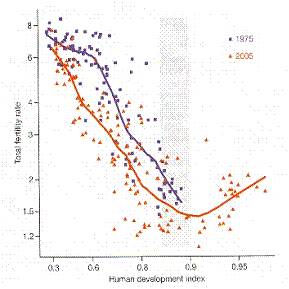
October 12, 2009
Mikko E V Myrskyla
Population Studies Center
University of Pennsylvania
3718 Locust Walk
Philadelphia, PA 19104
Dear Mikko E V Myrskyla:
I wrote you before and make bold to do so again for three things. First I wanted you to know that I am posting this letter as an open letter on nobabies.net, which is my web site. Second, I am enclosing a DVD which summarizes what I have been able to learn about population size and fertility, which appears to be at the heart of the demographic shift, which is in turn at the heart of your fascinating article Advances in Development Reverse Fertility Decline, NATURE, vol. 460 no. 7256 August 6, 2009 page 741. Third I shall review that article briefly, quoting in large part my earlier letter. If you have any comments to make I should only be too happy to add them.
In your article you show how you have discovered that past a certain level of social development, including such things as standard of living, education, infertility and longevity, the usual demographic shift of falling fertility as income rises is reversed. In the most developed societies, fertility is rising significantly but not high enough to reach replacement levels. This is your landmark graph. The vertical axis is total fertility and the horizontal axis is the human development index, which combines as well as can be done the various statistics that indicate how well developed a society is with the blue line indicating the scatter of countries in 1976 and the red line the same scatter thirty years later.

Sure enough the blue line shows what we have long known, that as social development improves, fertility declines. And the red line shows that as social development rises beyond any that had been achieved in 1976 the line turns back up.
Thrilling as the prospect of stable prosperous human populations is, you were careful enough to include data from 1975 as well as 2005. Between them, the two lines show that over 30 years there is a reduction of fertility at any given level of development so that the whole line shows a secular downward shift (SDS). Since heredity and environment determine human behavior, and since you have controlled for environment, the cause of the SDS must be genetic. There is one and only one genetic mechanism capable of having such a uniform global impact. Thousands of animal studies1 as well as a human study done in Iceland2 and another in Denmark3,4 show that if two humans (and most other animals) are not closely enough kin, there will be a reduction in fertility. These studies have already been sited on nobabies.net. Furthermore, the Danish study (which was published in two parts) specifically addresses the question of choice here. Neither income nor education had any detectable effect on fertility. The Iceland study does not mention choice explicitly, but their error bars are so tight – fertility is so tightly constrained by kinship – that there is little or no room for choice. And we can exclude choice in the animal studies; squirrels do not delay having families for reasons of career ambition. The shape of the curve of fertility against kinship is the same in all cases and it can be duplicated with a suitable computer program of the genetics of a virtual population.
Since SDS is genetic, the simplest thing to assume is that the entire demographic transition is due to the same mechanism; different countries have stepped on the sliding board at different times.
The SDS must continue as long as the cause continues. It looks from your data like a 30 % decline over 30 years, which probably translates into a 50 % fall over the next 30 years. Tragically that means that soon no country will be able to cross into the upward shifting fertility regime that now looks so appealing; they would have to go through a period of effectively no offspring. Unless mating strategies change in a fashion to control SDS, the less well developed societies will follow the richer into the demographic trap of being unable to have babies at all.
Thank you for your contribution to this most important field.
Sincerely,
M. Linton Herbert MD
1 On the Regulation of Populations of Mammals, Birds, Fish, and Insects. Richard M. Sibly, Daniel Barker, Michael C. Denham, Jim Hone, Mark Pagel SCIENCE VOL 309 22 JULY 2005 page 609
2 An Association between Kinship And Fertility of Human couples Agnar Helgason, Snaedbjoern Palsson, Daniel F. Guobjartsson, Pordur Kristjansson and Karl Stefanson, SCIENCE vol 319 8 February 2008 page 813
3 Human Fertility Increases with marital radius. Rodrigo Labouriau and Antonio Amorim. GENETICS volume 178 January 2008 page 603 figure 3.
4 Comment on “An Association Between the Kinship and Fertility of Human Couples,” Rodrigo Labouriau and António Amorim, SCIENCE vol 322 12December 2008 page 1634b
There have been 2,390 visitors so far.